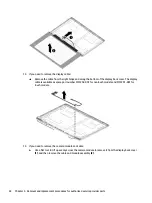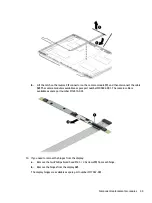
Questions and answers
Use this section to answer your questions about nonvolatile memory.
1.
How can the BIOS settings be restored (returned to factory settings)?
IMPORTANT:
The restore defaults feature does not securely erase any information on your hard drive.
See question and answer 6 for steps to securely erase information.
The restore defaults feature does not reset the Custom Secure Boot keys. See question and answer 7 for
information about resetting the keys.
a.
Turn on or restart the computer, and then quickly press
esc
.
b.
Select Main, and then select Apply Factory Defaults and Exit.
c.
Follow the on-screen instructions.
d.
Select Main, select Save Changes and Exit, and then follow the on-screen instructions.
2.
What is a UEFI BIOS, and how is it different from a legacy BIOS?
The Unified Extensible Firmware Interface (UEFI) BIOS is an industry-standard software interface
between the platform firmware and an operating system (OS). It replaces the older BIOS architecture but
supports much of the legacy BIOS functionality.
Like the legacy BIOS, the UEFI BIOS provides an interface to display the system information and
configuration settings and to change the configuration of your computer before an OS is loaded. BIOS
provides a secure runtime environment that supports a Graphic User Interface (GUI). In this environment,
you can use either a pointing device (touch screen, touchpad, pointing stick, or USB mouse) or the
keyboard to navigate and make menu and configuration selections. The UEFI BIOS also contains basic
system diagnostics.
The UEFI BIOS provides functionality beyond that of the legacy BIOS. In addition, the UEFI BIOS works to
initialize the computer’s hardware before loading and executing the OS; the runtime environment allows
the loading and execution of software programs from storage devices to provide more functionality,
such as advanced hardware diagnostics (with the ability to display more detailed system information)
and advanced firmware management and recovery software.
HP has provided options in Computer Setup (BIOS) to allow you to run in legacy BIOS, if required by the
operating system. Examples of this requirement would be if you upgrade or downgrade the OS.
3.
Where is the UEFI BIOS located?
The UEFI BIOS is located on a flash memory chip. You must use a utility to write to the chip.
4.
What kind of configuration data is stored on the DIMM Serial Presence Detect (SPD) memory
module? How would this data be written?
The DIMM SPD memory contains information about the memory module, such as size, serial number,
data width, speed and timing, voltage, and thermal information. This information is written by the
module manufacturer and stored on an EEPROM. You cannot write to this EEPROM when the memory
module is installed in a computer. Third-party tools do exist that can write to the EEPROM when the
memory module is not installed in a computer. Various third-party tools are available to read SPD
memory.
5.
What is meant by “Restore the nonvolatile memory found in Intel-based system boards”?
This message relates to clearing the Real Time Clock (RTC) CMOS memory that contains computer
configuration data.
6.
How can the BIOS security be reset to factory defaults and erase the data?
58
Chapter 8 Statement of memory volatility
Summary of Contents for Chromebook Pro c640 G2
Page 4: ...iv Safety warning notice ...
Page 8: ...viii ...







































